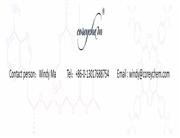| Description |
Palmitic acid is a kind of common saturated fatty acid of a 16-carbon backbone, which is contained in fats and waxes. It naturally exists in palm oil and palm kernel oil, and can also be found in butter, cheese, milk, meat, cocoa butter, soybean oil and sunflower oil. It can be produced by many kinds of plants and organisms. It can be used for the production of soap, cosmetics, and industrial mold release agents. It is also a food processing aid. It can also be used to produce cetyl alocohol which is useful in the production of detergents and cosmetics. Recently, it has been also used for the manufacture of a long-acting antipsychotic medication, paliperidone palmitate. |
| References |
https://pubchem.ncbi.nlm.nih.gov/compound/palmitic_acid#section=Top
https://en.wikipedia.org/wiki/Palmitic_acid |
| Chemical Properties |
white chips, crystals or powder |
| Uses |
Palmitic Acid is a common fatty acid found in plants and animals. The body converts excess carbohydrates into Palmitic Acid, thus Palmitic Acid is the first fatty acid produced during fatty acid synt hesis as well as a precursor for longer fatty acids. |
| Uses |
palmitic acid is one of the skin’s major fatty acids produced by the sebaceous glands. In cosmetic preparations, it is used as a formula texturizer. This acid is naturally occurring in allspice, anise, calamus oil, cascarilla bark, celery seed, coffee, tea, and many animal fats and plant oils. It is obtained from palm oil, Japan wax, or Chinese vegetable tallow. |
| Definition |
ChEBI: A straight-chain, sixteen-carbon, saturated long-chain fatty acid. |
| Safety Profile |
A poison by intravenous route. A human skin irritant. Questionable carcinogen with experimental neoplastigenic data. When heated to decomposition it emits acrid smoke and irritating fumes |
| Purification Methods |
Purify palmitic acid by slow (overnight) recrystallisation from hexane. Some samples are also crystallised from acetone, EtOH or EtOAc. The crystals are kept in air to lose solvent, or are pumped dry of solvent on a vacuum line. [Iwahashi et al. J Chem Soc, Faraday Trans 1 81 973 1985, pK: White J Am Chem Soc 72 1858 1950, Beilstein 2 IV 1157.] |

 China
China







